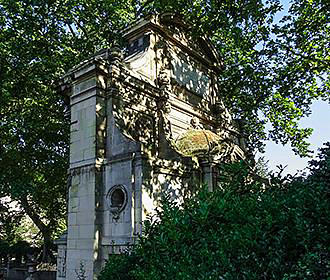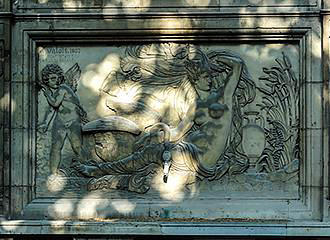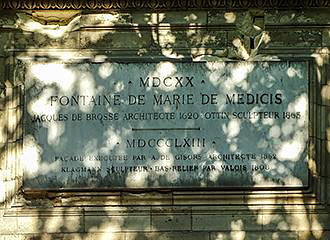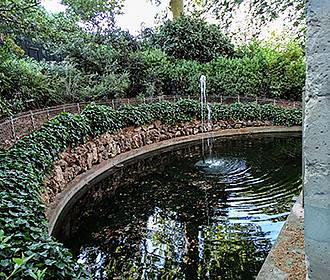Paris Fontaine de Leda Fountain in Jardin du Luxembourg
This was one of the fountains in Paris installed during the reign of Napoleon Bonaparte, however, this is a very little known and often missed water fountain, as although it is located in the Jardin du Luxembourg, it is hidden behind the Fontaine de Medicis.
Fontaine de Leda Fountain history
It was Napoleon Bonaparte who commissioned fifteen new fountains in Paris in the decree of Saint Cloud, which was in the May of 1806 and one of these was to become known as the Fontaine de Leda.
The project for this particular water fountain was given to the engineer called Francois Bralle, who was at that time responsible for the supply of drinking water in Paris, and a young sculptor by the name of Achille Valois was provided with the commission for the sculptural work.
It was designed to be fixed to a building, and therefore it was only the front facade of the fountain that would be seen, and on the pediment there was the Imperial sign of the eagle and the laurel wreath.
The Paris Fontaine de Leda bas relief depicts a mythical story where Jupiter has transformed himself into a swan to seduce Leda, and the cupid shooting an arrow is Amor, and with Leda holding the swan in her arms, the water was designed to spout from the bronze beak of the swan into a basin at the foot of the water fountain.
Yet, like many of the water fountains in Paris, unfortunately, until the Canal Saint-Martin and the Canal de l’Ourcq were completed, there was insufficient water supply to enable a fast flow of water and it really only trickled out, but was still functional and popular with the public.
Paris Fontaine de Leda the 1850s through to the present day
However, it was during the reorganisation of Paris that a road was to be extended, which was under the guidance of Baron Haussmann during the reign of Napoleon III, and this meant that the wall where the Fontaine de Leda was located needed to be destroyed.
Yet the architect in charge of promenades and parks in Paris, called Gabriel Davioud, wanted to preserve the fountain, and eventually he came up with the idea of placing the fountain at the back of the Fontaine de Medicis, which at the time was also being relocated within the Jardin du Luxembourg and reconstructed.
After all, being that the Fontaine de Leda was a wall water fountain, it had to be attached to something, which was the same scenario for the Fontaine de Medicis, yet there were also some changes made to this historical water fountain in Paris by the architect Alphonse de Gisors.
These include two fresh water nymphs, known as naiads in Greek mythology, that were positioned on the top of the Fontaine de Leda fountain, along with three masquerons, or masks, that were to spout water further down from the original beak spout and these elements were designed by the sculptor Jean-Baptiste Klagmann.
And although the Fontaine de Leda is one of the very little known fountains, this is still classified as an historical Paris monument that can be seen today, if you take the time to go round to the back of the Medici Fountain located in the Jardin du Luxembourg.
Visiting Paris Fontaine de Leda Fountain
Now as you have no doubt gathered from earlier, the Fontaine de Leda is literally positioned on the back of the Fontaine de Medicis, which is situated within the Jardin du Luxembourg, and you will find this on the north-east corner of the gardens close to the Palais du Luxembourg.
Located within the 6th Arrondissement, as for getting to this historical monument and water fountain via Paris public transport, the nearest Metro stations are the Vavin stop serving line 4 or the Notre Dame des Champs stop serving line 12.
Yet the Paris bus lines 21, 27, 38, 58, 82, 83, 84 and 89 along with the Noctilien Night Bus via Lines N14, N21 and N122 will get you close by, as will some of the tours in Paris such as Paris TooBus tours.
Alternatively, if you are travelling into Paris via the RER trains, then you will find that the nearest RER train station is the Luxembourg stop serving line B, but for those of you who enjoy a bit of exercise, then there is a Velib station for the self service bike hire scheme also located in walking distance of the Jardin du Luxembourg Gardens.



